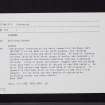Cramond
Building (Period Unassigned), Corn Drying Kiln (Period Unassigned), Midden (Period Unassigned)
Site Name Cramond
Classification Building (Period Unassigned), Corn Drying Kiln (Period Unassigned), Midden (Period Unassigned)
Alternative Name(s) Edinburgh, Cramond
Canmore ID 50461
Site Number NT17NE 77
NGR NT 189 769
Datum OSGB36 - NGR
Permalink http://canmore.org.uk/site/50461
- Council Edinburgh, City Of
- Parish Edinburgh (Edinburgh, City Of)
- Former Region Lothian
- Former District City Of Edinburgh
- Former County Midlothian
NT17NE 77 189 769
See also NT17NE 3.00.
Exploratory trenching at the north rampart of the Roman fort (NT17NE 3) to the west of the north gateway, has revealed demolition of a stone and mortar building. An area of flooring had been levelled with three layers of mortar and coaldust. A slabbed threshold and adjacent postholes indicate a possible entrance. Finds of glass and pottery suggest that the building could have been in existence at the end of the 18th century. An early 19th century map shows a building at this location. It appears to have been built on the remains of the fort's clay rampart. To its north are the remains of rubbish pits, containing oyster and other shells.
V E Dean 1988.
NT 1899 7698 Exploratory trenching has revealed a stretch of mortar floor, similar to that noted in 1988 (Dean 1988), a length of mortared stone wall, and parallel to it a stone-built drain, partly stone-capped and partly cobble-filled. The drain may have been cut through a cobbled roadway. Although the downhill side of the roadway has been eroded, it appears to be on the alignment of Old Street of Cramond Village. Some 0.3m below this was another surface of large cobbles and pink sandstone, incorporating oyster shells.
Sponsors: City of Edinburgh Council Archaeology Service, Edinburgh Archaeological Field Society.
V E Dean 1997
NT 1899 7698 A geophysical survey was made to the W of the exploratory trench in which a length of mortared stone wall was found (Dean 1997). A high-resistance area could represent the continuation of the wall westwards for c 8m at which point high resistance suggests that the wall turns through a right-angle northwards. High resistance to the S of this angle may indicate a T-junction in the wall. The survey is being continued in greater detail.
Sponsor: Edinburgh Archaeological Field Society.
H M D Jones 1999
NT 1899 7698 Continuation of trenching showed that the mortar floor noted in 1997 (Dean 1997) overlay a clay bank aligned with a possible threshold slab. South of this, rubble from the 1826 demolition of a village house (DES 1994, 47) overlay a small corn-drying kiln or bread oven. A rubbish pit was found to contain a 15th-century thimble and white gritty pottery. From a stone bank came a whale's vertebra, its flat surfaces bearing cut marks.
V E Dean 1999.








